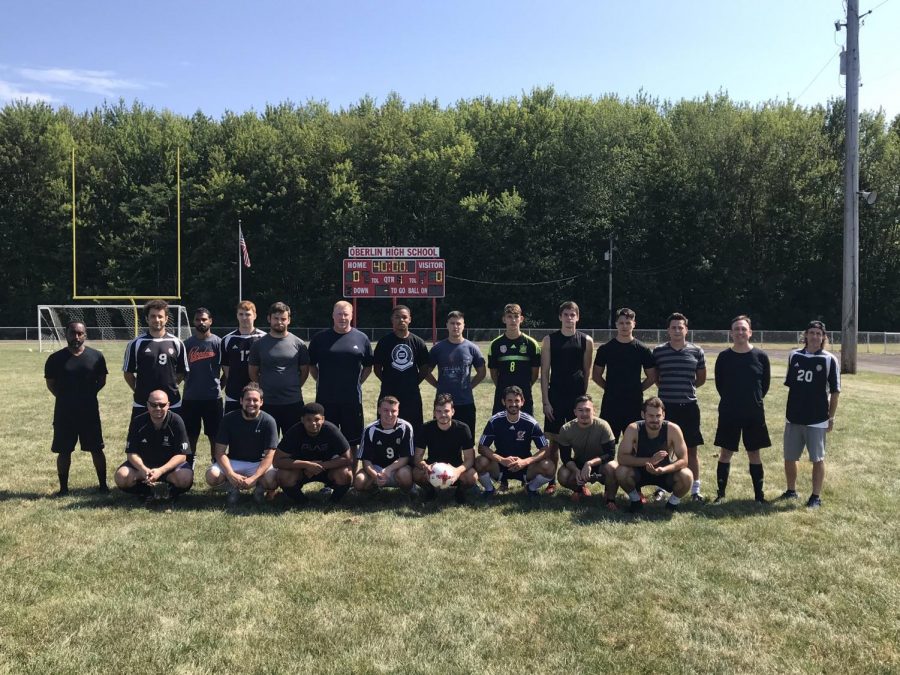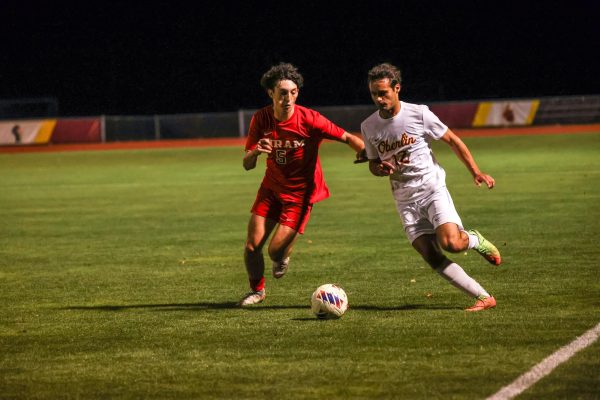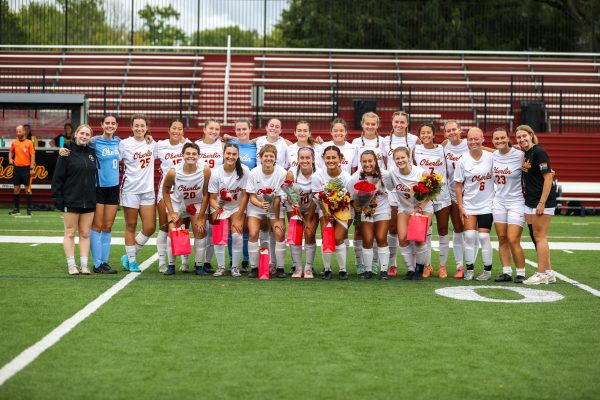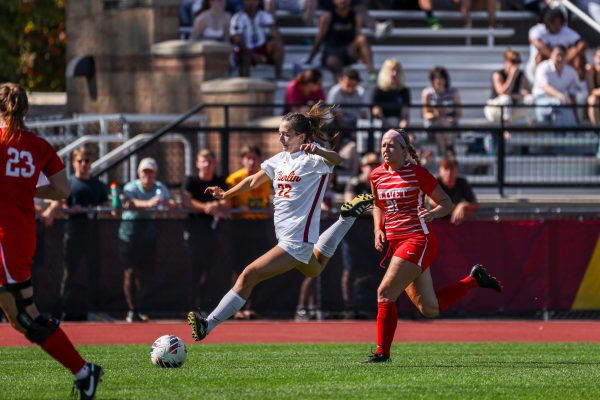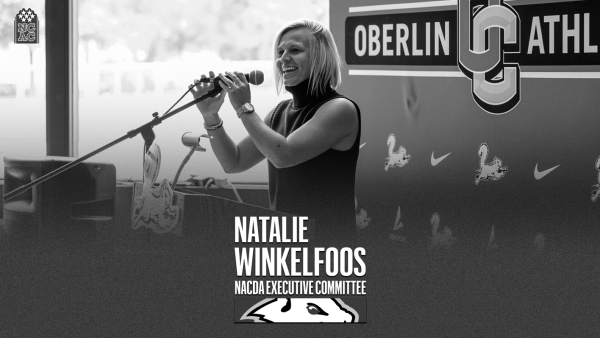Local Soccer Culture Values Diversity, Passion for Sport
Oberlin High School soccer alumni team poses before their 2019 game.
If you step on the field of a local youth, high school, or pickup soccer game in Oberlin, you will see unmatched passion and a respect for the game. This would not have been the case 50 years ago, since soccer’s roots in Oberlin are fairly new compared to other sports. Basketball, for example, has played a central role in Oberlin’s culture for a longer time, and there are unfading local traditions surrounding it. However, over the last few decades, Oberlin has embraced soccer and continues to form a rich culture around the sport through foreign influence, inclusivity, and passion for competition.
Meiraff Meshesha grew up in Oberlin in the 1970s and ’80s and says at that time soccer was a second-tier sport compared to football, baseball, and basketball; there was little television coverage of the sport across the United States. However, it was around this time that kids in Oberlin began to explore the game.
Meshesha moved to Oberlin in 1978 when he was two years old with his parents, who immigrated from Ethiopia. He was introduced to soccer through local recreational teams which were mostly coached by parents who had little soccer knowledge but cared about giving kids a chance to exercise and be a part of a team. To advance his soccer skills, Meshesha and his group of soccer-loving friends began playing at local fields with Oberlin College players who came from all parts of the world.
“Everything was there — the different styles of play, different attitudes about play,” Meshesha said. “And we learned all these different techniques to do different things. We completely fell in love with it. We were immersed in a ‘world soccer’ culture.”
Meshesha described playing informal games at Hales Gymnasium, Philips gym, and under the streetlights of Harkness Bowl during his childhood. When he was in high school, Meshesha and his friends’ dedication to soccer led to an opportunity to play on teams that traveled to Europe during summers after showing their skills at a local camp. Meshesha believes the experience was essential to bringing a high level of soccer back to Oberlin, and the Oberlin High School team he played on benefited.
“People thought we were a little bit crazy, but they also saw that we were playing at a slightly different level, and it inspired some of the other players,” Meshesha said.
In addition to gaining experience playing against high levels of competition, Meshesha believes access to watching the highest levels of soccer can help improve a player’s skills. He mentioned the presence of YouTube and the televising of European professional leagues as tools for young soccer players.
Liam McMillin, OC ’17 who grew up in Oberlin and played on the OHS team, echoed Meshesha’s ideas about international soccer’s influence on Oberlin through popular media. McMillin recalled playing early versions of FIFA and how he and his friends would style their play from their favorite players in the video game in the early 2000s.
After graduating high school, McMillin found ways to stay connected to the soccer scene in Oberlin. He served briefly as an assistant coach when he was a student at the College and stayed connected in other ways. One of McMillin’s favorite Oberlin soccer traditions is the alumni game, a matchup between the OHS varsity team and OHS alumni from any year. McMillin and Meshesha both spoke about this annual event.
“Something I remember from my first time playing as an alum was the way the other alumni thought about the game and changed the game,” McMillin said. “For the most part, people were there to help the [OHS] team get better.”
McMillin recalled Meshesha’s participation in alumni games and how he would always take the opportunity to turn plays into teaching moments for the OHS players. Meshesha remarked that the alumni have seen strong OHS teams at alumni games over the years since he graduated in 1994.
“We came back for alumni games where teams that we played were solid,” Meshesha said. “We saw players that played as a team — where everyone was developed enough to hold a quality of play and competitiveness.”
Members of Oberlin’s soccer community have also stayed connected through informal competitions. Meshesha, who now coaches in Los Angeles, organized pick-up soccer for many years in Oberlin.
“I could never not organize ball,” Meshesha said. “I had to play. I have been doing that since 1994. Wherever I go, I advocate for some sort of pick-up.”
McMillin, who now studies law in Cincinnati, had also been a part of this pick-up group for several years.
“Close to 30 or 40 people would come out pretty regularly,” McMillin said. “It was a mix of young players and some older folks. It was a wide range of backgrounds. Sometimes I played with people who I didn’t share any language with but could communicate with in soccer terms.”
This idea of inclusivity and diversity appears to be a central part of Oberlin’s soccer culture.
Janae Johnson, a second-year soccer player at Westminster College, had an illustrious career for the OHS girls’ varsity team and grew up playing soccer in the town on both girls’ and boys’ teams.
“Playing for Oberlin teams allowed me to build relationships with people that I could also spend time with outside of soccer,” Johnson said. “A lot of my teammates became more than just my teammates.”
She also noted the feeling of inclusivity in Oberlin’s soccer culture when she played on boys’ teams.
“Over about 10 years of playing with different boys’ teams in Oberlin, I never felt like I was treated any differently by my teammates or coaches,” Johnson said. “I also think that the inclusivity is unique because I don’t remember seeing many other girls playing with the boys’ teams we faced.”
In addition to a culture of gender inclusivity, there are shifts in racial and economic diversity within Oberlin’s soccer teams. McMillin, who said that he played on mostly white OHS teams a decade ago, feels he has seen these changes in the years since graduating.
“Soccer [at OHS] was generally a pretty white sport, and Oberlin is not all that white a town,” McMillin said. “In terms of the city itself, it’s a very diverse place. Seeing guys come out to play recently who weren’t just College professors’ kids — College professors’ kids playing soccer is such a trope in my mind — is great to see.”


